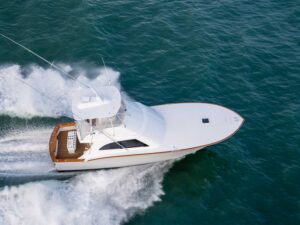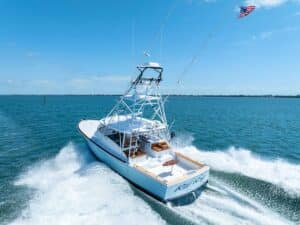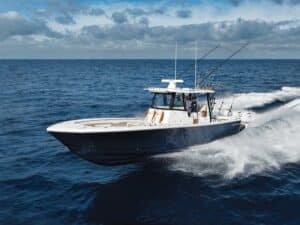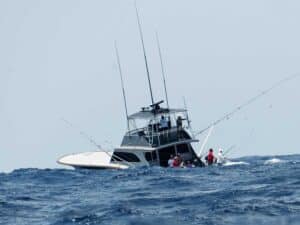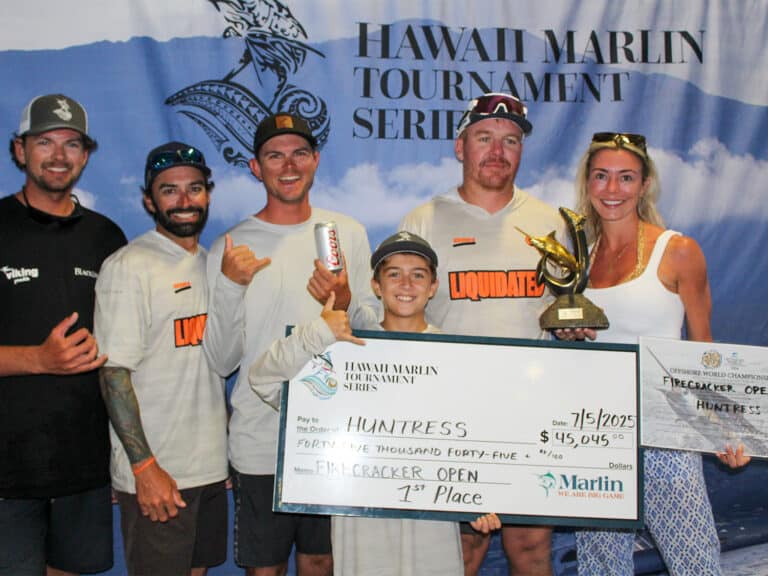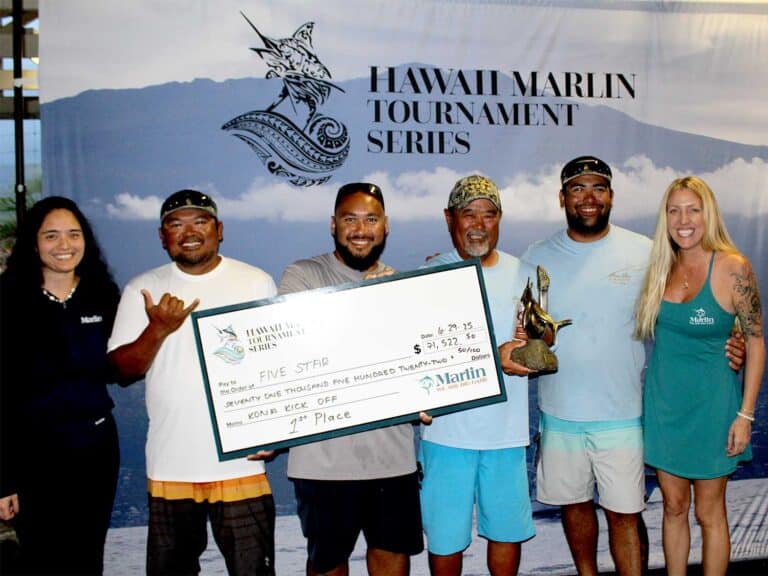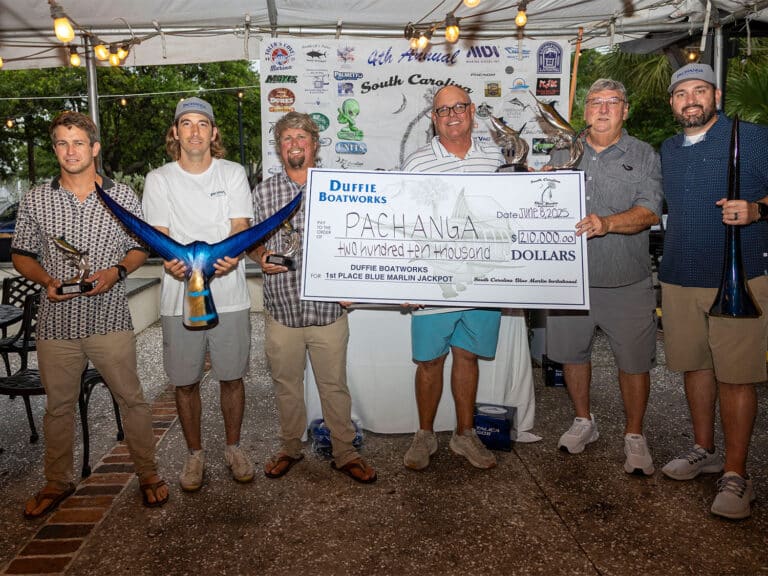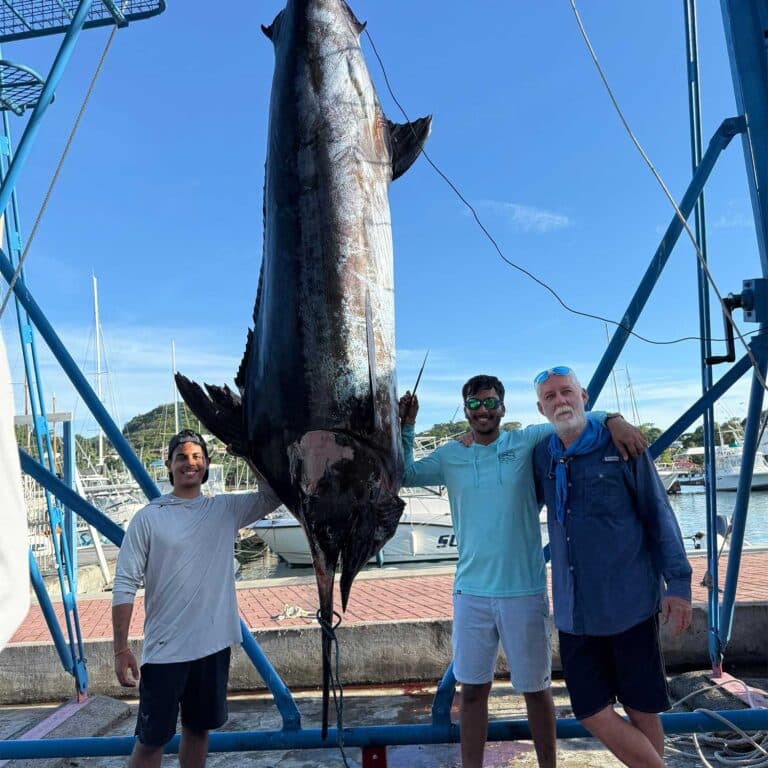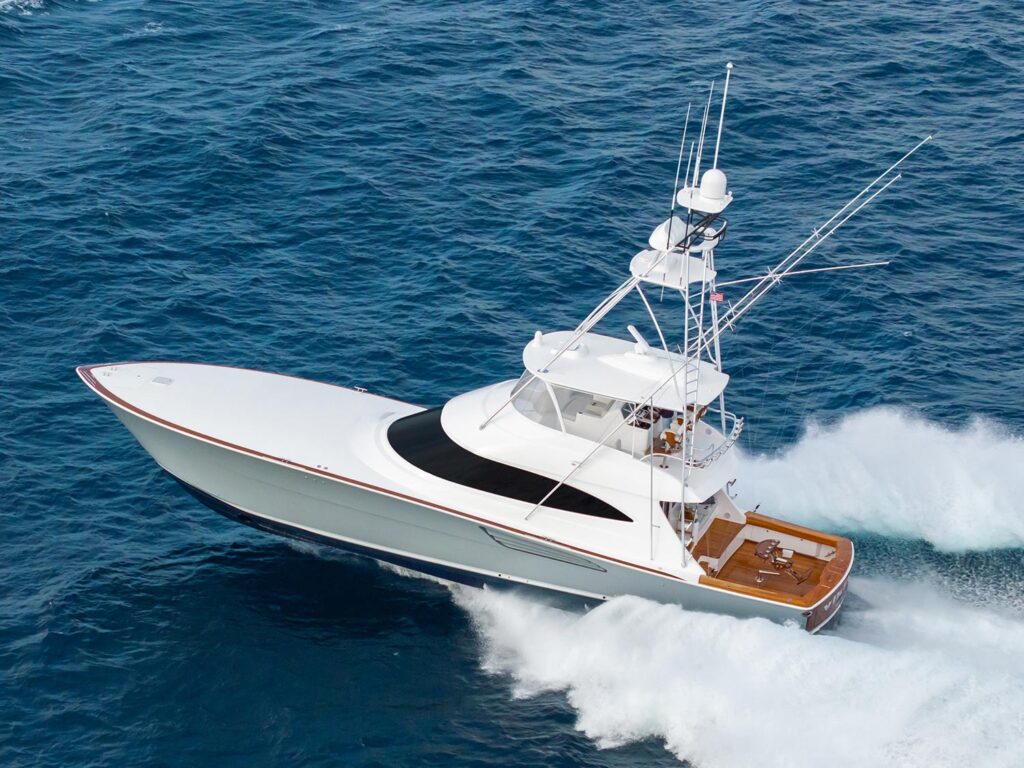
Special delivery: Sign up for the free Marlin email newsletter. Subscribe to Marlin magazine and get a year of highly collectible, keepsake editions – plus access to the digital edition and archives.
Over the past 60 years, the Viking Yacht Company has been relentless in expanding its formidable fleet with an unyielding commitment to build a better boat every day. When brothers Bill and Bob Healey rolled open the factory doors on April 1, 1964, a couple dozen craftsmen skillfully built each hull with carvel-planked mahogany timber, a seamless technique where each plank met flush with the board above and below. Decades later when the new Viking 74 had its world premiere at the 2024 Fort Lauderdale Boat Show, it made the event three-and-a- half months ahead of its planned delivery date, thanks to a dedicated work force of over 900 shipwrights in the New Gretna, New Jersey, factory on the Bass River.
Viking prides itself on being vertically integrated throughout the design and manufacturing process where the vast majority of every Viking yacht is built in house. From the design, to the fiberglass molds made from five-axis profiling equipment, the Viglass fiberglass workers, a spacious mill for rough and finished carpentry, to the metal shop, Viking exemplifies teamwork.
With the new 74 appearing at the Lauderdale show alongside its most recently launched stable mate, the Viking 82 which debuted at the company’s Dealer Meeting in June, Viking President and CEO Pat Healey explained, “There’s no resting on your laurels.”
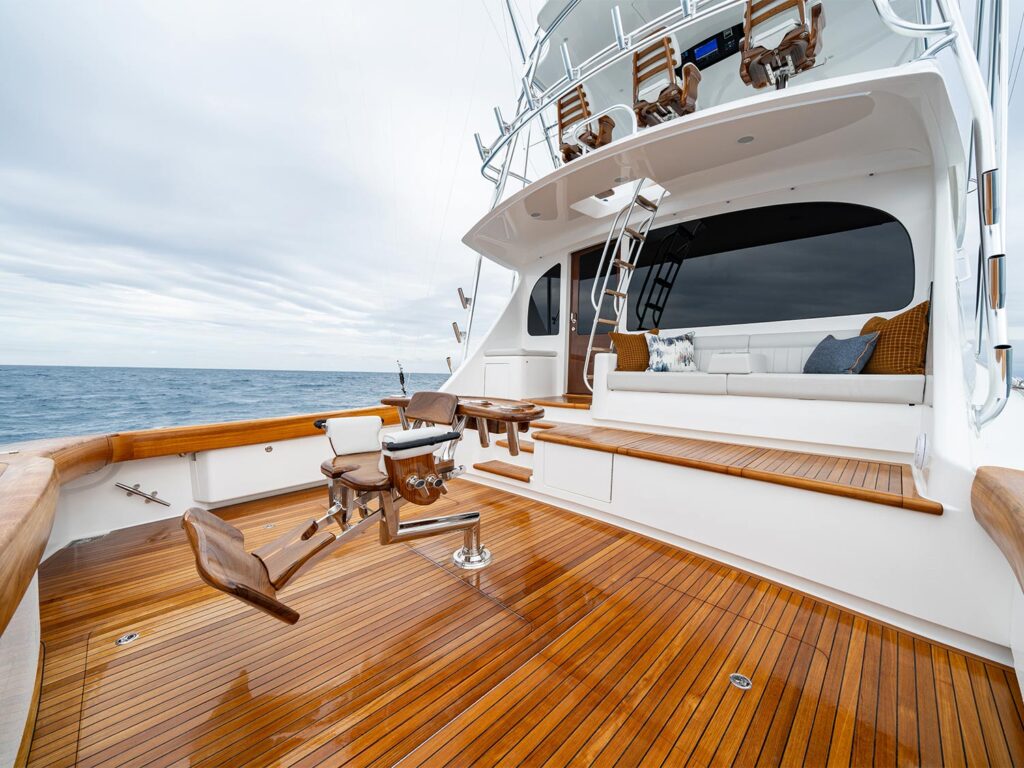
Cockpit, Mezzanine & Bridge
Thousands of tournament fishing hours help explain the functionality of the 216-square-foot cockpit, which measures almost a foot longer than the cockpit of the 72. An aluminum backing plate is laminated into the fiberglass sole to secure a fighting chair, rocket launcher or table. Both 12V and 24V outlets are mounted under the port and starboard coamings for seamless deep drop and kite fishing convenience. Glendinning Cablemasters for dockside electric are in port and starboard lockers with a cut out to keep the cable off the deck. A pair of full length fishboxes with stainless-steel gas pistons and split lids are recessed beneath the sole and are insulated, removable and outfitted with drain plates and pump outs for easy cleaning. A transom livewell can be augmented with two on deck livewells along with threaded fittings that drain directly overboard. A refrigerated cockpit step box keeps anglers refreshed and close to the action. A transom door with a lift gate is standard, as well as fresh and raw water wash downs. The observation mezzanine keeps guests close to the action but clear of the anglers in the lower cockpit. Ample stowage is provided for gear, fishing tackle, and bait freezers. Creature comforts include available air conditioning and the fly bridge overhang offers protection from the sun and weather. A large hatch opens to access the lazarette and the Seakeeper gyro.
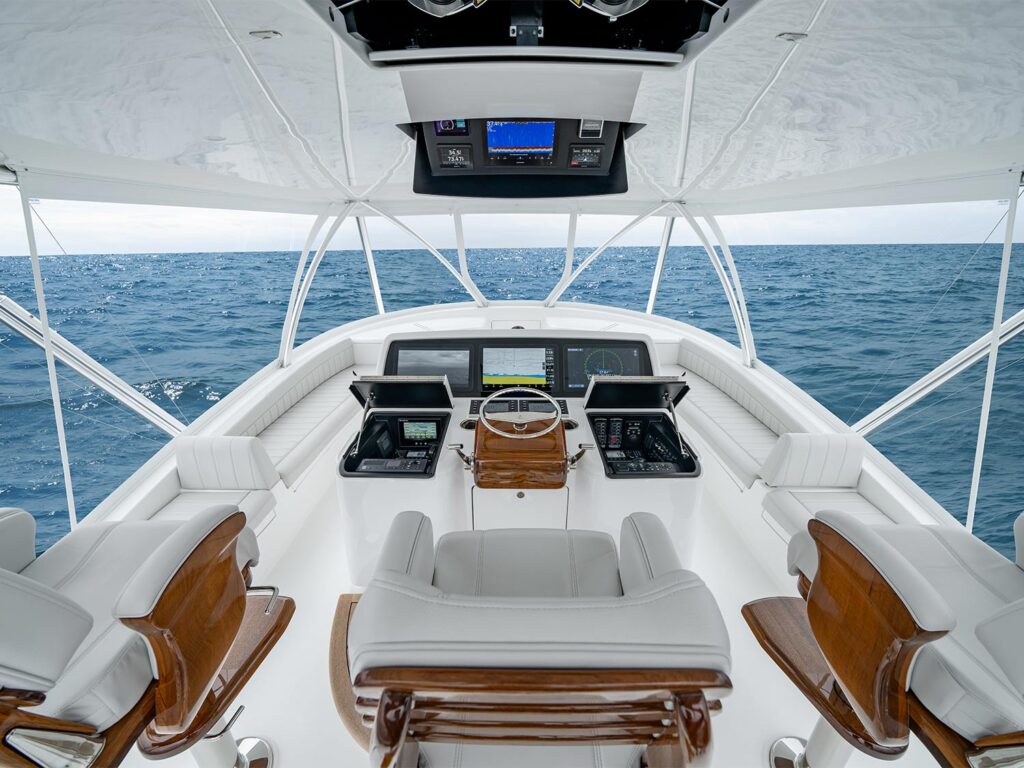
A seven-inch high platform gives unfettered 32-point visibility from the center console command station with a Release Marine teak helm pod and flanking single lever controls with built-in buttons for the Sleipner hydraulic bow thruster. Dedicated batteries are installed in the console to supply power to the electronics. In a raised pod, Viking’s subsidiary Atlantic Marine Electronics installed three 19-inch Seatronx screens fed by Furuno, Garmin and other electronics. Two banks of MTU engine vitals are on center for easy monitoring. Recessed port and starboard radio boxes with split lids contain Icom VHFs, an Octoplex monitor, Seatronx keypads, accessory switches, the FLIR color thermal camera, Furuno Navnet controls, Rupp outrigger controls, and remote controls for the Furuno CSH8L full circle scanning sonar. In an overhead compartment of the fiberglass hardtop, there are controls for the Seakeeper 26 gyro (Seakeeper 40 is also available), the Optimus steering, a Garmin 8612 plotter, and Garmin auto-pilot. A second overhead compartment is the home for a pair of Miya Epoch electric teaser reels. Palm Beach Towers, also a Viking subsidiary, designed and outfitted the tuna tower with another bank of navigation and operating equipment in the 63-inch-long control box in the upper station. A handy freshwater outlet also is provided. Both AME and PBT provide the convenience and expertise to deliver the boat turn-key ready.
An extended overhang provides ample room to move behind the three Release Marine ladder-back helm and companion chairs. Additional seating is afforded with the port and starboard lounges with stowage and removable backrests, as well as an integrated lounge forward of the helm with a massive freezer below. Additional freezers are forward along with a refrigerated drink box cooler, and a sink and freshwater outlet. A Costa Clear enclosure and bridge air conditioning are available options.
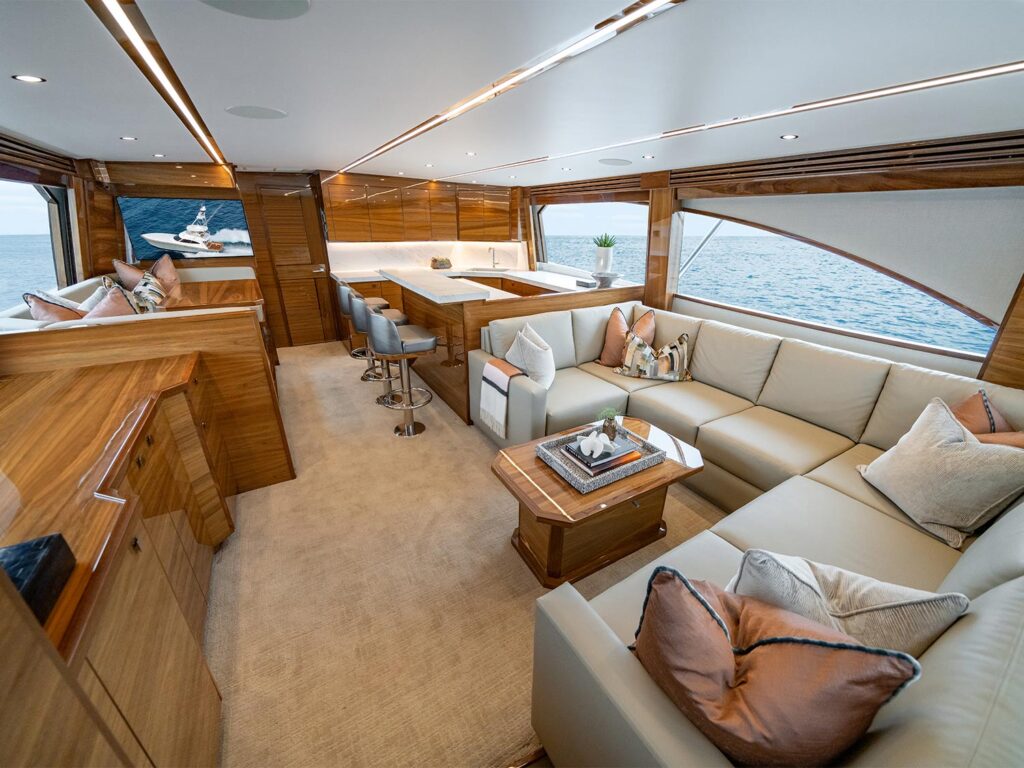
Interior, Engine Room & Performance
The Viking 74 is a tournament contender, designed to fish hard but sports a luxurious interior to relax after a day on the deep and to travel in comfort. Owners can choose from several interior layout options to best suit their specific needs. Our test boat featured a gloss horizontal grain walnut finish. Satin also is available at no charge. Stepping inside the air conditioned environment, the day head is immediately to port. Adjacent to the port head door is the full height touch screen electrical panel. To starboard the sofa and cocktail table are opposite the 55-inch television that rises from the cabinetry. The test boat had a U-shape galley with custom Amtico flooring, stone countertops and three bar stools. The open galley option provides a walk-through arrangement with a slightly smaller sofa. Premium appliances for both galley layouts include a Miele electric cook top, with a conventional oven below, a Sharp convection/microwave, Sub-Zero refrigerators and freezers, a deep stainless-steel sink with a garbage disposal, ice cube maker, and plenty of stowage space for cookware and food supplies. On the port side is a raised dinette with walnut table with a rod-storage drawer below and room on the bulkhead for another television. A walk-in pantry sits forward of the galley.
Below, four staterooms offer comfort and privacy, each with ensuite heads with Headhunter MSDs and fiberglass shower stalls. The master stateroom has a king walk around bed with a premium Handcraft mattress and a 40-inch flat screen television. The VIP forward has a queen bed, or can be ordered with crossover berths. Crew quarters are accessed from the companionway or the engineroom. The companionway also houses an Asko washing machine and dryer, and a tackle room. However, the tackle room is large enough to become a fifth stateroom if desired.
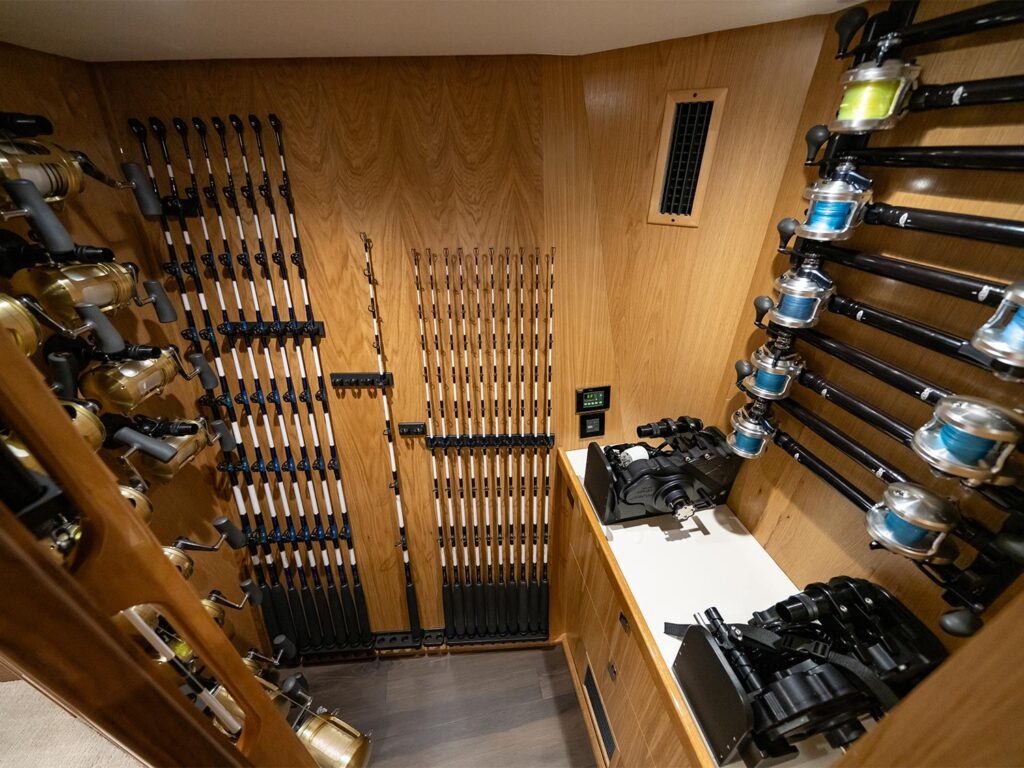
When first getting aboard a large convertible, there is always a learning curve, but in the case of the Viking 74, this process is facilitated by careful and clever arrangements the builder is known for. Starting with 69 inches of headroom between the 16-cylinder MTUs, getting outboard of each engine is easy. All bilge areas are painted with snow white Awlgrip and the four-inch thick fiberglass overhead with thermal and acoustical insulation for the salon above is polished so brightly it appears as a mirror with the abundance of lighting. Abaft each engine is a 29 kW Onan generator. Above each genset is a Craftsman tool chest. Lift any hatch and the Awlgrip bilge gleams. All components are clearly labeled. There is an Electrosea Seastrong Silver Bullet pump with a second back-up unit already plumbed and wired and an Electro Strainer Pro for the centralized seawater system, a Headhunter freshwater pump, a Spot Zero water maker combo, two Dometic four-ton chilled water air conditioning units with sea water supply/discharge manifolds for isolating each chiller for maintenance, Tides dripless shaft logs, a gear type oil changing system for the mains, transmissions and gen sets with a pump out line to the cockpit, and the Delta T engine room ventilation system. Even the bronze through hulls and strainers in the bilge are coated with Awlgrip.
Construction features a blister resistant vinylester in the hull skin, and a custom blended polyester resin in the structural laminates, topsides, fly bridge and hardtops. The hull is infused with Baltek end-grain balsa and Airex foam cores with carbon, and E-glass hybrid laminates. Viking-made fuel, water and waste tanks are infused, and feature fiberglass baffles on the inside, balsa coring on the outside and are sealed to the hull with syntactic foam. Stringers are foam filled and encapsulated in fiberglass. Composite bulkheads are vacuum bagged.
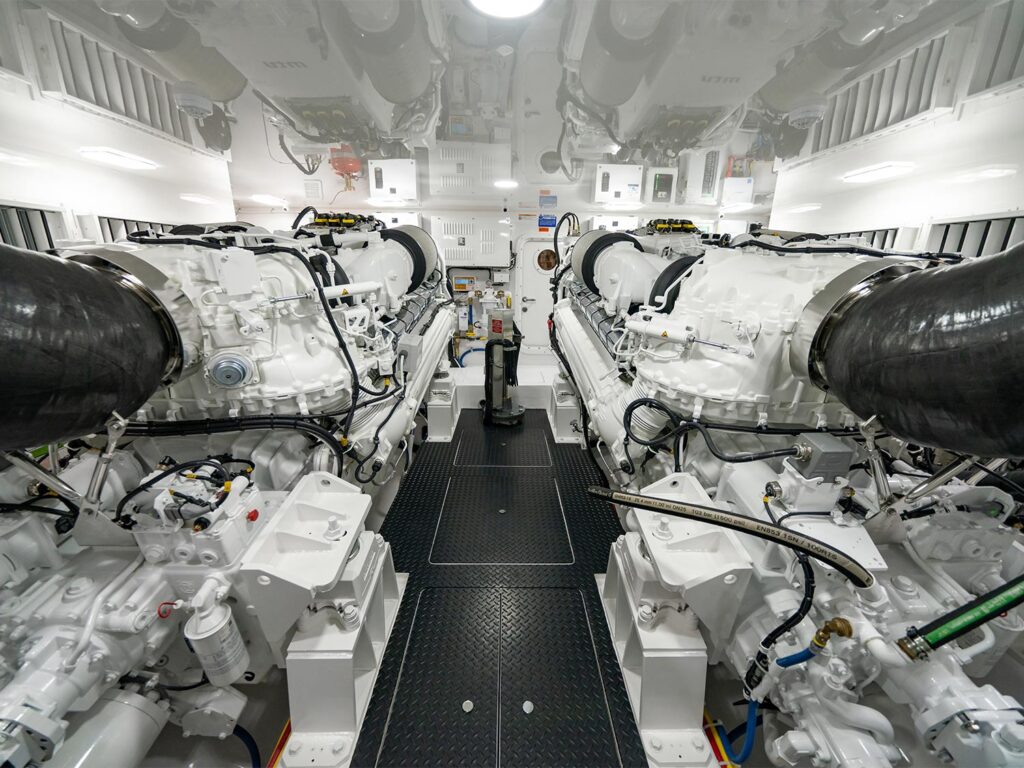
The Viking 74 had a blazing act to follow in replacing the Viking 72, the fastest ride in the six-decade history of the company. The 72 Convertible ran 45 knots and racked up 75 sales, the number of boats delivered. Its replacement had a short list of boxes to check: more room, equally fast, stellar style, fishability, and plush accommodations. Back in 2004, Viking built its first 74 convertible, the largest boat in the Viking catalog at the time, with a hull that was designed in-house by Bruce Wilson, the company’s legendary design maven. A model of the hull was fabricated and tank tested at the Stevens Institute of Technology in Hoboken, New Jersey, and when the boat was finally launched, it had a top speed of 37 knots. Larger MTU engines soon saw the 74 ascending to 40 knots.
Familiarity breeds success in the Viking tradition. Wilson’s son David has taken the role as the Design Manager and where once the drawing board was the focus, these days designs are facilitated on a computer screen with Computational Fluid Dynamics software, a process that Viking has mastered for several years now. Instead of countless tank runs, CFD provides instant direction about fine tuning performance, how the running surface reacts in numerous sea conditions, how weight affects resistance, and how minute changes allow the design group to dial in the best possible refinements for speed and seakeeping characteristics.
In the ocean off Palm Beach earlier this year, the new Viking 74 powered with a pair of MTU 16V2000M96L diesels and full of the standard fuel, water, fishing gear and three people eased along at 24.8 knots at 1500 RPM, averaging 100 GPH and a range of 448 miles. At 2452 RPM with all of the quiet and well-behaved ponies out of the stable and heading south in the Gulf Stream, I recorded 45 knots on the Garmin GPS. The mid-range provides a variety of useful speeds. At 2000 RPM the boat slipped along at 35.7 knots burning 196 GPH; and 33 more RPM brought on a speed of 36.8 knots. At 2130 RPM, speed was a solid 39.5 knots. This is not a lightweight boat but it takes advantage of the available power and a running surface with lift strakes and chines to ride on top rather than digging a hole to break free and reach planing efficacies. Modified struts and rudders treat the water differently to minimize resistance, allowing the five-bladed Veems a bigger bite with every turn. The response at the helm is instant and maneuvering in tight circles to create slop to generate some spray revealed that the aggressive chine shape ignored my efforts to cover the broad foredeck with salt water.
Building a better boat every day is Viking’s mantra and just those few words have resulted in a family empire that goes to sea to prove its heritage. As Pat Healey reminds us, there is no resting on laurels to build a better boat every day.
Viking Yacht 74 Specs
- LOA: 74’8”
- BEAM: 19’9”
- DRAFT: 5’11”
- DISPL: 135,994 LB. (standard fuel, full water)
- FUEL: 2,030 GAL. (standard)
- FUEL: 2,630 GAL. (optional)
- WATER: 360 GAL.
- POWER: TWIN MTU 16V2000M96L 2,635HP EA.
- GEAR/RATIO: ZF 2.773:1
- PROPELLERS: VEEM 5 BLADE
- CLIMATE CONTROL: DOMETIC
